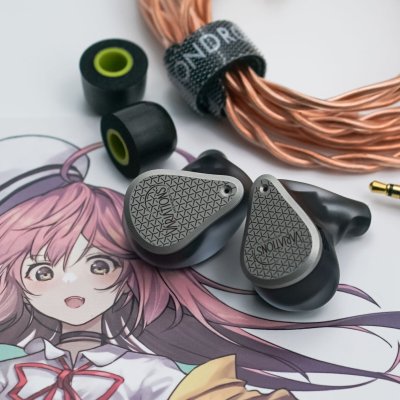Moondrop Variations and FlipEars Aegis use 1DD+2BA+2EST and 1DD+1BC driver setups respectively. Moondrop Variations costs $550 while FlipEars Aegis costs $479. Moondrop Variations is $71 more expensive. Moondrop Variations holds a slight 0.3-point edge in reviewer scores (7.5 vs 7.2). User ratings place Moondrop Variations at 7.5 and FlipEars Aegis at 8. FlipEars Aegis has better bass with a 0.7-point edge, Moondrop Variations has significantly better mids with a 1.6-point edge, Moondrop Variations has significantly better treble with a 1.3-point edge, FlipEars Aegis has better dynamics with a 0.6-point edge, Moondrop Variations has significantly better soundstage with a 2.8-point edge, FlipEars Aegis has slightly better details with a 0.3-point edge and FlipEars Aegis has better imaging with a 0.5-point edge.
Insights
| Metric | Moondrop Variations | FlipEars Aegis |
|---|---|---|
| Bass | 7.3 | 8 |
| Mids | 7.1 | 5.5 |
| Treble | 7.5 | 6.3 |
| Details | 7.3 | 7.5 |
| Soundstage | 7.8 | 5 |
| Imaging | 7 | 7.5 |
| Dynamics | 6.2 | 6.8 |
| Tonality | 7.4 | 6.8 |
| Technicalities | 7.6 | 7 |
Moondrop Variations Aggregated Review Score
Average Reviewer Scores
Average Reviewer Score:
7.5Generally Favorable
FlipEars Aegis Aggregated Review Score
Average Reviewer Scores
Average Reviewer Score:
7.2Generally Favorable
Reviews Comparison
Moondrop Variations reviewed by Jaytiss
Youtube Video Summary
Build & accessories: Variations shows its age. The resin shell fits well and the metal faceplate looks clean, but the body feels a bit chintzy and slightly see-through, with a chunky nozzle compared to newer slim designs. The pocketable case is nice, yet the stock cable is thin with barely visible L/R markers; modular termination is handy, but modern Q-Lock-style systems do it better.
Sound: tuning centers on energetic, engaging vocals with a tasteful sub-bass lift—not a bass-head set, more a polite, gradual boost. A dip around the lower mids can read as thinness, pushing some female vocals a touch distant, while the top end has air, detail, and an overall chill presentation. Technicalities are solid rather than class-leading at the price, but the EST implementation is clean and cohesive. Expect limited mid-bass weight, occasional shout for the sensitive, and ergonomics that won’t suit everyone.
Context & verdict: despite a wave of competitors (Oracle MK2, Hype 4, Softears Studio 4/Volume S, AFUL Performer 7, DUNU Brain Dance, even Moondrop’s own Dusk at a lower price), this tuning remains a benchmark reference around the mid-fi bracket. Variations delivers the archetype many listeners still chase: clean sub-bass, airy treble, and a deft, easygoing balance that makes it a “legendary” set in the catalog. Not flawless, but noteworthy—the kind of IEM worth borrowing at a meet and auditioning for 10–15 minutes to see if that lighter midrange flavor clicks.
Jaytiss Youtube Channel
Buy Moondrop Variations on HiFiGO
Ad
Price: $479
Buy Moondrop Variations on HiFiGO
FlipEars Aegis reviewed by Jaytiss
Youtube Video Summary
FlipEars Aegis presents a striking build: a sturdy, slightly resin-like shell with a visible bone conductor puck at the back, a metallic-feeling nozzle, and a deeply recessed 2-pin connector. The copper-hued cable feels premium, holds its chin slider position, and arrives in 4.4 mm—appropriate for the price. Packaging stands out thanks to a genuinely luxurious leather case that looks and feels high-end, easily the sort of accessory that elevates the unboxing experience.
Sonically, Aegis graphs with a pleasant bass shelf but pushes hard into the upper mids, which can read as shouty and colored, especially on vocals and spoken word. The shell/driver exhibits a subtle “pingy” reverberation—a resonance noticed when the housing is tapped—that contributes to a slightly piercing presentation at volume. It retains some fun, bouncy energy reminiscent of sets like Campfire Trifecta, yet the overall balance trends more V-shaped, with detail and resolution not quite matching expectations for the bracket.
In context, alternatives such as FlipEars Legion come across more refined with better mids and detail, while budget picks like the Kiwi Ears Atude (~$120) feel better judged in the upper-mid energy. Stepping up, something like THIEAUDIO Origin (also using bone conduction) provides a more convincing technical package. Aegis can be shaped into a much more enjoyable listen with EQ—notably by trimming upper mids and smoothing the 300 Hz region—but without EQ it sits in a niche: a visually beautiful, bass-friendly IEM whose tuning quirks and resonance limit broader appeal.
Jaytiss Youtube Channel
Moondrop Variations reviewed by Jays Audio
Youtube Video Summary
Moondrop Variations tracks the compensated diffuse-field target closely at typical listening levels (75–85 dB), delivering a signature that is clean, smooth, airy with center-locked imaging. The well-known mid-bass tuck trades some weight on male vocals, bass guitars, and kick drums for top-tier separation and midrange clarity, while the sub-bass rises with a subwoofer-like rumble and texture. Treble is generally coherent and extended, though a touch of extra energy past 12 kHz can turn hot on brighter J-/K-Pop masters. At sane volumes, the overall presentation feels correct and harmonious, with instruments and vocals popping out in a spacious, non-congested stage.
Against Blessing 2 Dusk, Variations sounds clearer and more separated with better sub-bass extension; Dusk’s added mid-bass gives male vocals more heft but softens the subwoofer illusion and feels less smooth up top, making female vocals a bit less airy. For listeners wanting a touch more slam and a gentler treble tilt, sets like Shuoer EJ07M and the original Monarch provide that extra meat without wrecking clarity. On a budget, the Moondrop Quarks DSP offers a “mini-Variations” vibe—~85% of the experience—though it gives up some treble extension, bass texture, and imaging precision due to driver and DSP constraints.
Big picture: for accuracy, balance, imaging, and an almost studio-monitor take in an IEM, Variations remains a go-to recommendation—especially if there’s no strong preference for extra mid-bass or if listening stays below 85 dB. Those chasing more bite or “out-of-the-box” coloration can find sharper sets, but they won’t sound as even, faithful, or effortlessly clear as Variations at moderate volumes.
Jays Audio Youtube Channel
FlipEars Aegis reviewed by Jays Audio
Jays Audio Youtube Channel
Moondrop Variations reviewed by Smirk Audio
FlipEars Aegis reviewed by Smirk Audio
Moondrop Variations reviewed by Head-Fi.org
FlipEars Aegis reviewed by Head-Fi.org
Moondrop Variations (more reviews)
Moondrop Variations reviewed by Super* Review
Youtube Video Summary
Moondrop Variations enters the $520 bracket as a sleek tribrid (DD bass, BA mids, dual EST treble) that mirrors the Blessing 2 shell and fit—complete with the familiar large nozzle—while upgrading the look with a smoky, beach-glass finish. The package is generous (tips, foams, spare filters, and a modular cable with 3.5/4.4/2.5 swaps), though the case is bulky and the connector mechanism isn’t the slickest. Ergonomics are essentially the same as Blessing 2/Dusk; secure once sealed, but best with smaller tips.
Sonically, this reads as a refined “Dusk-plus”: a flatter lower-mid profile, prominent yet tidy sub-bass, and treble that’s a touch smoother and better extended than Blessing 2/Dusk. Despite measuring with more sub-bass than Dusk, it often feels less bassy in practice—more integrated, less showy—while preserving the line’s standout midrange detail and vocal clarity. Versus peers, staging depth benefits from the sub-bass lift (a hair more “space” than Blessing 2), and detail/resolution is effectively on par with Dusk; Blessing 2 still edges it for midrange naturalness, and all-BA sets like S8 retain the treble finesse crown.
The catch is value: performance moves forward, but only by small, picky margins. With Blessing 2/Dusk sitting a full $200 lower, Variations feels like a tasteful refinement rather than a categorical leap. For listeners who want a neutral core with an articulate sub-bass emphasis and slightly more air/polish up top than the Blessings—without the Dusk’s heavier bass feel—it’s an excellent pick. As scored, it earns 4 stars: easy to recommend on its tuning and competence, just shy of “must-buy” given how close its cheaper siblings perform.
Super* Review original ranking
Super* Review Youtube ChannelMoondrop Variations reviewed by Gizaudio Axel
Gizaudio Axel original ranking
Gizaudio Axel Youtube ChannelMoondrop Variations reviewed by Crin
Crin Youtube Channel
Moondrop Variations reviewed by Kois Archive
Kois Archive Youtube Channel
Moondrop Variations reviewed by Tim Tuned
Youtube Video Summary
Packaging brings typical Moondrop flair—an anime-clad box, a large but well-built carrying case, assorted foam and silicone tips, and interchangeable plugs (3.5/2.5/4.4). The shells look sleek and minimalist, with a stock cable that’s better than usual for the brand. Fit mirrors the Blessing 2 profile—still on the larger side—but slightly more comfortable over long sessions.
Sonically, this is a sub-bass focused set with minimal mid-bass, yielding deep, clean rumble and zero bleed. The midrange is refined and clear, giving female vocals spotlight treatment, while male vocals can feel a touch thin due to the leaner lower mids. Treble is well-extended with a hint of air, avoiding peaks, sibilance, and fatigue. The headline is separation and microdetail—attack/decay snap notes into place so instruments occupy distinct spaces, producing imaging that’s confident and a stage that’s wide enough for the price.
Against $500 peers like Kiwi Ears Orchestra and Thieaudio Oracle, Variations competes directly; Oracle may sound warmer and more natural on male vocals, but Variations pushes ahead with cleaner layering and a more modern, sub-bass fun tilt. At around $530, it delivers a taste of $1k-class resolution without sacrificing musicality—an easy five-star recommendation for listeners who want clarity, air, and subterranean slam over extra mid-bass warmth.
Tim Tuned Youtube Channel
Moondrop Variations reviewed by Shuwa-T
Moondrop Variations reviewed by Audionotions
Moondrop Variations reviewed by Precogvision
Youtube Video Summary
Moondrop Variations takes the Harman idea and fixes what that target often gets wrong. The tuning pushes sub-bass with minimal mid-bass, plus a dip around ~200Hz that cleanly separates lows from the rest—think speaker rig with a dedicated sub. Midrange is clear yet forward, bordering on shouty in noisy environments, with thinner lower-mid body. Treble is the standout: a smooth, extended EST implementation with real air to ~15kHz—softer in attack than some sets, but among the few EST tunings that actually feel coherent at this price. Build echoes Blessing 2’s large shell, fit is good for larger ears, and the cable’s swappable termination is a practical upgrade.
Technical performance is where Variations surprises. Detail retrieval is top-tier for ~$520, edging past well-known mid-fi competitors and clearly a step up from the Blessing line; imaging is solid if not showy, while dynamic contrast and punch are unusually engaging. Bass quality shows better texture and slam than earlier Moondrops, even if the absolute best DD bass in class still belongs elsewhere. The overall presentation is energetic, clean, and high-contrast—notes pop against a dark low end and lit upper mids/treble.
Against peers, DUNU SA6 suits listeners wanting smoother, laid-back treble and a less insistent midrange, whereas Shuoer EJ07M offers a bouncier bass shelf but a less even top end. Compared with Moondrop’s own Blessing 2/Dusk, think “Dusk on steroids”: bigger sub-bass, more resolution, and more punch—though Dusk owners won’t see a night-and-day jump. Imperfections aside, on paper this is one of the most complete packages in its bracket, especially for those who value sub-bass authority, clarity, and a refined EST treble without sacrificing coherence.
Precogvision Youtube Channel
Moondrop Variations reviewed by Nymz
Moondrop Variations reviewed by Yifang
FlipEars Aegis (more reviews)
FlipEars Aegis reviewed by Web Search
The FlipEars Aegis delivers a visually stunning and sonically powerful experience, featuring hand-painted, medieval-inspired rose-brass faceplates that make each unit a unique work of art. Its hybrid driver configuration—combining a dynamic driver with FlipEars’ proprietary Earquake bone conduction driver—generates a thunderous, tactile bass response that dominates the low end without overwhelming the mids. Comfort and isolation are excellent despite the ornate design, and the package includes a premium 4.4mm balanced cable and versatile accessories.
Sound-wise, the Aegis excels with a holographic soundstage that creates an arena-like sense of space and depth, while its midrange remains articulate and richly textured. Vocals cut through the mix with natural presence, and instruments retain impressive separation even in complex tracks. The treble, though slightly relaxed, offers enough air and control to avoid fatigue, making it ideal for long listening sessions despite lacking sparkling energy.
At under $500, the Aegis is a phenomenal value, delivering technicalities that rival higher-priced competitors, particularly in bass physicality and stage immersion. Its slightly darker tuning prioritizes musical engagement over analytical sharpness, cementing it as a top choice for bass enthusiasts seeking refinement and grandeur.
Moondrop Variations Details
Driver Configuration: 1DD+2BA+2EST
Tuning Type: U-Shaped
Brand: Moondrop Top Moondrop IEMs
Price (Msrp): $550
Support our free service! Buying through our affiliate links costs you nothing extra:
FlipEars Aegis Details
Driver Configuration: 1DD+1BC
Tuning Type: Basshead
Brand: Flipears Top Flipears IEMs
Price (Msrp): $479
Support our free service! Buying through our affiliate links costs you nothing extra:
Moondrop Variations User Review Score
Average User Scores
Average User Score:
Based on 2 user reviews
7.5Strongly Favorable
FlipEars Aegis User Review Score
Average User Scores
Average User Score:
Based on 1 user reviews
8Very Positive
Moondrop Variations Gaming Score

Gaming Score & Grade
- The gaming score is prioritizing technical capabilities of the IEM (Separation, Layering, Soundstage) and good value.
Gaming Score
7.1Gaming Grade
A-FlipEars Aegis Gaming Score

Gaming Score & Grade
- The gaming score is prioritizing technical capabilities of the IEM (Separation, Layering, Soundstage) and good value.
Gaming Score
6.7Gaming Grade
B+Moondrop Variations Scorings
Average Technical & Tuning Grades
Average Tunign Grade
A-- It balances warmth and clarity well, showing only minor quirks along the way. Timbre feels believable with most instruments.
Average Technical Grade
A- It delivers a confident technical showing with defined layers and satisfying clarity. You can follow backing vocals with relative ease.
FlipEars Aegis Scorings
Average Technical & Tuning Grades
Average Tunign Grade
B+- Tonality is generally agreeable, though a few bumps remind you of its limits. Certain tracks spotlight its tonal quirks.
Average Technical Grade
A-- A competent technical showing keeps separation intact while delivering modest staging. It feels tidy even when recordings stack layers.
Moondrop Variations User Reviews
Share your experience and build your personal ranking list.
You need to be signed in to write your own reviewTaught me Harman is not for me...
Pros
Clean and clearCons
Recessed lower mids, a bit too calm and lifelessThis was one of my first IEMs. I loved it and hated it. It is still the cleanest sounding IEM I own - also compared to something much more expensive.
Pros
Very clean sound signature combined with a satisfying amount of sub-bass. Sounds great with the right songsCons
Thin mids and poor note weight in some songsFlipEars Aegis User Reviews
Share your experience and build your personal ranking list.
You need to be signed in to write your own reviewA near-classic under $500: delivers thrilling bass texture via bone conduction, lush mids, and cathedral-like staging—perfect for bassheads who refuse to sacrifice detail or build quality.
Pros
Exceptional bass depth and physicality with zero muddiness, holographic soundstage that feels massive, and stunning hand-painted design that looks far more expensive than its price.Cons
Slightly dark treble lacks airiness for some genres, and larger shells may cause fit issues for small ears during extended use.Find your next IEM:
IEM Finder Quiz
newIEM Comparison Tool
newVS

























